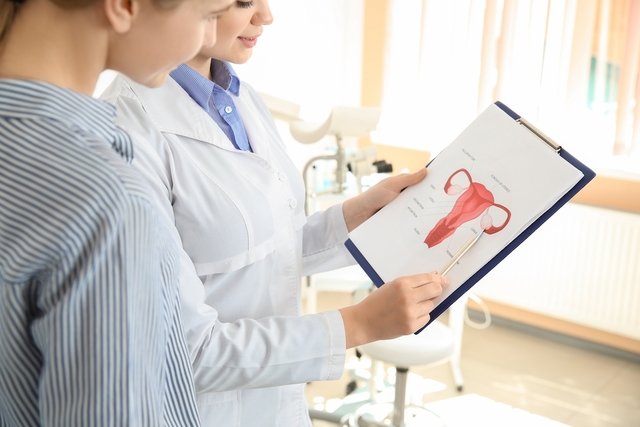Multifollicular ovaries are ovaries that have a greater number of follicles than normal, leading to the production of small cysts and resulting in symptoms such as irregular menstruation and severe cramps.
This increase in the number of follicles is caused by hormonal changes that mean that the follicles produced do not reach maturity, remaining accumulated in the ovaries, not releasing the egg and ovulation not occurring.
The treatment of multifollicular ovaries is carried out by a gynecologist and generally involves the use of oral contraceptives or the use of medications capable of inducing ovulation.

Symptoms of Multifollicular Ovaries
The main symptoms of multifollicular ovaries are:
- Irregular menstruation or absence of menstruation;
- Strong cramps;
- Acne;
- Excess hair on the face;
- Weight gain.
These symptoms may appear as small cysts form in the ovary.
Although multifollicular ovaries are not related to infertility, it is common for women who have this change to have difficulty getting pregnant, as the ovulation process is compromised.
Therefore, if a woman wishes to become pregnant, it is important to consult a gynecologist so that the most appropriate treatment can be indicated.
How to confirm the diagnosis
The diagnosis of multifollicular ovaries is made by a gynecologist through evaluation of symptoms, health history and the use of hormonal contraceptives.
Make an appointment with a gynecologist in the nearest region:
Taking care of your health has never been easier!
To confirm the diagnosis, the doctor must request a pelvic or transvaginal ultrasound, in which it is possible to visualize the size of the ovaries and the presence of cysts.
Additionally, your doctor may also order blood tests to check your hormone levels.
What is the difference between multifollicular ovaries and polycystic ovaries?
Despite leading to similar symptoms, multifollicular and polycystic ovaries are different situations.
Polycystic ovaries are characterized by the presence of many cysts in the ovary, which are distributed irregularly throughout the ovary and are larger.
On the other hand, multifollicular ovarian cysts are smaller and occur due to the lack of maturation of the follicles and, consequently, lack of ovulation. Check out some common questions about polycystic ovaries.
Possible causes
Multifollicular ovaries are caused by hormonal changes, mainly FSH released by the hypothalamus in the brain, which stimulates the release of estrogen, leading to the development and maturation of follicles.
When there is a change in this hormone, the follicles do not mature, becoming accumulated in the ovaries, leading to the formation of small cysts, and resulting in symptoms.
How the treatment is carried out
The treatment of multifollicular ovaries must be carried out under the guidance of a gynecologist and involves the use of medications capable of regulating hormonal levels, such as contraceptives, for example.
If the woman does not ovulate during treatment, the gynecologist may recommend the use of medications capable of inducing ovulation. See the main remedies to induce ovulation.
In cases where the use of contraceptives and ovulation-inducing medications are not sufficient, the doctor may recommend surgery to remove the cysts.
Is multifollicular ovaries curable?
Multifollicular ovarian syndrome has no cure, but can be controlled with medication. These medications can be useful for regularizing menstruation and reducing symptoms caused by the disease.
Women who have multifollicular ovaries also have greater difficulty getting pregnant, as they do not ovulate every month, and it is recommended to follow the treatment proposed by the doctor and take medications that can induce ovulation, such as clomiphene, in addition to being recommended to have intercourse at all times. fertile periods. See what the symptoms are and how to calculate the fertile period.
Bibliography
- PHY, J.; et al. Transvaginal ultrasound detection of multifollicular ovaries in non-hirsute ovulatory women. Ultrassound in Obstetrics & Gynecology. 23. 4; 183-187, 2004
- BOZKURT, M.; et al. 2-D and 3-D ultrasonographic characteristics of the ovary in women with PCOS and multifollicular ovaries. J Obstet Gynaecol. 41. 6; 920-926, 2021

Sign up for our newsletter and stay up to date with exclusive news
that can transform your routine!
Warning: Undefined array key "title" in /home/storelat/public_html/wp-content/plugins/link-whisper-premium/templates/frontend/related-posts.php on line 12
Warning: Undefined array key "title_tag" in /home/storelat/public_html/wp-content/plugins/link-whisper-premium/templates/frontend/related-posts.php on line 13




